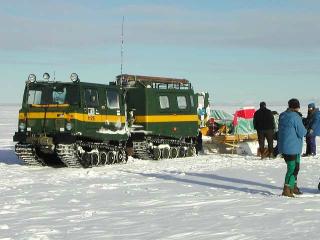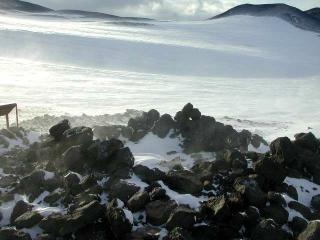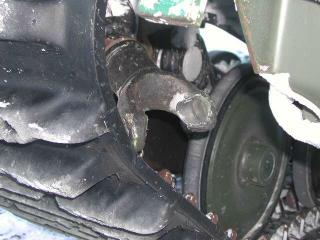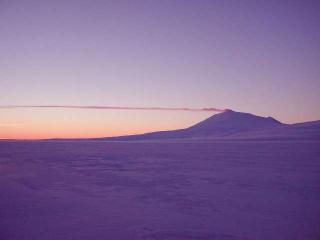| Antarctica - Nuggies On Ice |
| [ Home > Other Pages > Worst Journey ] |
| This story details the events that occurred on a trip we took to Cape Crozier, (at the eastern end of Ross Island), during March of 2002. This is an account of what were probably the longest four days that we have ever had to endure. From our own personal viewpoint, we felt a little of what the explorers of the Heroic Age of polar exploration had gone through. Read on ... |
| Cape Crozier - The Worst Journey in the World - (Our Version) |
| One of the fun things to do before the days become too short each year is to take an overnight camping trip to Cape Crozier at the eastern end of Ross Island. There were two reasons for making the trip. The first was to visit the historic site of the stone igloo used by Henry Bowers, William Wilson and Apsley Cherry-Garrard during the winter of 1911, when they visited Cape Crozier to obtain Emperor Penguin eggs, as part of their scientific programme. (The saga of their journey is contained in the book, "The Worst Journey in the World", by Cherry-Garrard.) The second reason was to climb Post Office Hill and The Knoll to gain an overall view of the Cape Crozier area. Two trips were organised, with half of the Winter Team going on each trip, so that fire crew minimum requirements on base could be met. The plan was for each trip to take 3 days - one day travelling to Cape Crozier, one day looking around the area and one day travelling back to Scott Base. After a delay for bad weather, the first team set out on a gloriously fine Wednesday. Their journey to Cape Crozier went without problems and they established their camp in a suitable snow-covered area, (snow-covered in order to be able to drive tent pegs in). The next day, however, they woke to a blizzard, with snow driving across the ground and high wind speeds. This meant that they were tent-bound for the day. However, the third day dawned clear and sunny with little wind and they were able to get their sightseeing done. They climbed Post Office Hill, where they had a great view of the B-15A iceberg that is jammed between Cape Crozier and Franklin Island. Returning to their camp, they decided to pack up and return to Scott Base, visiting the stone igloo soon the way back. Following the blizzard of the day before, they had a little work to do digging their Hagglunds transport out of the snow and clearing snow from the inside that had blown in through a window that had not been fully closed. From there the journey back to Scott Base via the stone igloo was accomplished without incident and they arrived back late on Friday evening. The second group was then going to start out the following day, but once again the trip suffered a weather delay and the trip did not start until Sunday. Annette and I were in this second group and were quite looking forward to visiting an area that is considered relatively inaccessible. The trip started with overcast skies in the McMurdo Sound area. We followed a flagged GPS route across Windless Bight to Cape Mackay. If anyone thought that the Ross Ice Shelf was a flat expanse of ice then this myth was rapidly exposed. Apart from the obvious dangers of crevasses and the sastrugi formed in the hard packed surface snow, there were amazing giant rollers in the ice. Almost like an ocean swell frozen in time the rollers stretched off towards the shore of Ross Island. At times we could see the full distance to the horizon and then all we could see was white surrounding us as we drove into the bottom of a roller. Very impressive! |
| Throughout the journey we stopped at one-hourly intervals to make a routine radio schedule. Once past Cape Mackay we could no longer use VHF radio and had to use our HF rig. By now the cloud was starting to clear and we made good time, under improving conditions, to Cape Crozier. Once we arrived at Cape Crozier, we established our camp in the same spot as the previous trip - for one thing we did not have to level the snow to set up our tents. The tents we used are basically the same design as those used by Scott and his party in 1911 - they worked then and they still work well now. Our American friends call the design "Scott tents", we call them "polar tents". |
| After getting the camp established, we started out exploring. The Knoll, a small volcanic peak, was a short distance away and we didn't take long to get there. Climbing The Knoll was a little difficult due to the slopes being mostly cinder and scoria-type rock. From the top, there was a good view of the setting sun on the face of the B-15A iceberg. By now it was starting to get dark and we made our way back to camp. On our way back, we came across tracks in the loose gravel terrain. These had been made 30 years ago by a bulldozer sent to Cape Crozier to recover some failed equipment. The fact that the tracks could be seen for kilometres, standing out as if they had been made yesterday and not 30 years previously, served as a timely reminder of |
| how long human impact lasts in Antarctica and how careful you really have to be not to disturb the environment. We were really looking forward to our evening meal of stew and mashed potato. No matter what it is, a hot meal is always welcome in the cold of Antarctica. Once we were fed and the dishes were done, we had a hot drink while waiting for our nightly radio schedule time of 9pm. We had noticed that the temperature had been dropping since we arrived and following the schedule we tucked ourselves up in our sleeping bags inside our "warm" tents. We also tested the Iridium phone that we were carrying as an emergency backup to radio communications. The next day was going to be brilliant - or so we thought. |
| Sleeping in a tent in the Antarctic under snow conditions is a bit of a mission at the best of times. Beds consist of a thermal mattress to sit on the groundsheet and then a sleeping kit made up of a brushed cotton inner, followed by a polar weight down sleeping bag, then another polar sleeping bag, (with a hood), and finally a thick cotton outer layer to protect the sleeping bags from stones and other sharp objects. Getting into the sleeping bags requires some time, as the cotton inner does not move freely when fine snow starts to melt on clothing as you get into the bag. Fifteen to twenty minutes later and you can say that you are in and comfortable, but then you have to wait while your body heat warms the inside of the bag. Pretty soon you are off to sleep, very warm and reasonably comfortable. During the night you become aware that something is falling on your face, that is, if your head is out of the sleeping bag hood. Looking up at the tent walls there are feathery ice crystals hanging from the material, formed from condensing breath. Every so often they become too heavy to support themselves and you have a mini-snowfall of your own. We got out of bed the next day in time for the morning radio schedule at 9am and were greeted by clear skies, warm sun and no wind. By the time we had a hot drink and a snack for breakfast - all of an hour - the sun had disappeared behind thick cloud and a cold mist had rolled in from the Ross Ice Shelf. Suddenly it was very cold and snow started to fall. Snow fell for most of the rest of the day until about 4pm. When it stopped, the mist was gone and the sky was starting to clear. It was looking good for the morning, but for the moment it was still bitterly cold. (We found out later, when we returned, that the temperature had dropped that day to -32 degrees centigrade at Scott Base and was likely to have been colder at Cape Crozier.) The slight, wispy breeze wafting up the slope of the glacier we were camped on should have been a warning, but for some reason we all ignored it. Another hot meal and then we prepared ourselves for fighting our way into our sleeping bags once more. When we tried to complete our 9pm radio schedule, Scott Base could not receive us. We were able to talk to MacRelay at McMurdo and they told us that there had been a solar flare that was interfering with HF communications at polar latitudes. We asked them to pass on to Scott Base that we were all well and still fine. Luckily we had the backup Iridium phone if radio reception conditions got worse. Getting into the sleeping bags that night was quite a bit more difficult as there was quite a lot of fine snow in clothes that only seemed to shake loose inside the tent. Because it is so dry in Antarctica snow does not normally stick together and behaves a lot like dust - it gets everywhere. The result was that the cotton inner of our sleeping kits stuck to us a lot more than usual and it took longer to get into the sleeping bags. This made us a lot warmer when we finally made it all the way in, but it also meant that we were now perspiring more and the inside of the sleeping bags was starting to get damp. For the moment though, we were comfortable once more. Sometime during the night a herd of banshees were unleashed in the Cape Crozier area and descended on our campsite with amazing fury. It was still dark when the attack started. The tent walls were whipped to a frenzy by the onslaught of the blizzard. There was a constant snowstorm of condensed breath and spindrift being blasted through the tent. The blizzard continued to blow through the 9am radio schedule, but lying in a sleeping bag and using the Iridium phone it was easy to call home. However, answering the call of nature was not so easy. Getting out of the sleeping bag, dressing in all the cold weather clothes and pushing drifted snow out of the way of your tent flap is guaranteed to make the call all the more pressing. Once outside the tent, the sun could be seen faintly through the blowing snow. Above us it was a fine day. However, winds blowing at over 50 knots do not allow you to appreciate your surroundings and we were soon back in the tent and making the, by now, huge effort to get back into our sleeping bags. And that's where we stayed for the next 24 hours, less the time for one more call of nature, listening to the winds climb in speed. We estimated the wind peak to be over 85 knots, (170 kilometres per hour), so were glad to have some protection in our tents. On Wednesday morning the wind was still blowing strongly, although it showed signs of easing. Dragging myself out of my sleeping bag, I made the 9am schedule call and dressed myself for the required trip outside. Moving the snow from the tent door was a lot harder this time because there was more of it. Once outside the day wasn't too bad. Lots of wind, but very little driven snow - most of it was probably on the way north over the Ross Sea by now. The sun was shining and there was about 5 kilometres visibility. I woke the trip leader and suggested that as conditions had improved, we should perhaps make a break for home. After checking conditions for himself, the decision was made and we started to break camp. It was decided to leave the polar tents up until Chris, the mechanic, had started the Hagglunds - just in case there was a problem. As it turned out, it took Chris about 3 hours to get the Hagglunds started. The first problem encountered was that the radiator and engine bay were packed full of blown snow. It took some time to dig out and dry the electrics. Chris then found that the ignition cables were arcing due to moisture and more drying had to be applied. At last the Hagglunds burst into life and, after 15 minutes running, the decision was made to pull down the tents. With everything packed on the towed sledge, we set off down the glacier towards Igloo Spur to see the stone igloo before we left the Cape Crozier area. |
| When we reached Igloo Spur, the Hagglunds engine stopped again. Chris said this wasn't a problem and we should go to look at the stone igloo. The wind was still blowing fit to bust and we were blown over a couple of times walking to and from the igloo. The first thought that crossed my mind regarding the trip of 1911, was not so much that they were brave men, but that they had made a big mistake by erecting their shelter on the windiest ridge in the Cape Crozier area. The wind was howling over the top of the ridge that was perched between two glaciers. This view of the stone igloo is looking from the southwest up the glacier towards The Knoll. Blown snow can be seen to the left, passing at around 40 knots, (80 kilometres per hour). Since it was bitterly cold once more, our visit to the igloo was short and we soon made our way back to the Hagglunds again. This was when we |
| found that the Hagglunds wouldn't start after all. Realising that we were in deep trouble, 80 kilometres from Scott Base, with disabled transport and limited shelter on this exposed glacier, we called for reinforcements on the HF radio. Another Hagglunds and a personnel carrier would be dispatched from Scott Base the next day. In the meantime though we appeared to be stuck where we were. There were two primary jobs that had to be done. While Chris continued to work on why the Hagglunds wouldn't start, we had to make sure we had shelter for the coming night. Working away quietly, Chris quickly found the answer to why the Hagglunds wouldn't start. The contact end of the distributor rotor arm had all but disappeared due to excessive arcing from being damp. In true MacGyver fashion, this did not worry our hero too much. With a "we can fix that", he set about rigging a temporary repair. Cutting away the damage to expose the rotor contact, he sawed a slot into the contact and broke off a piece of hacksaw blade small enough to rotate in the distributor. This was wired in place using a few strands of copper from a piece |
| of electrical wire. The rotor was placed back in the distributor and tested to see if there was clearance. Satisfied that all was well, Chris switched on the engine and it burst immediately into life. While all this was going on, the rest of the team had been busy finding somewhere to set up the tents. There was no snow-covered area anywhere near us and they were setting up a polar tent on the icy slope of the glacier we found ourselves on. The site chosen was right next to the Hagglunds so that the tent could be tied to the vehicle for safety. There was no snow available to make a smooth campsite and nothing to drive tent pegs into |
| except ice. Ice screws would have to be used. The decision had already been made that we would try to cram everyone into the Hagglunds for the night, but the tent would be used if needed. The tent was almost up when the engine kicked into life again. The tent came down a lot faster with the realisation that we were going home after all. We all got back in the Hagglunds and down the glacier we went to the Ross Ice Shelf. Soon after we reached the ice shelf we stopped to pick up the first set of flags marking the route. These had been placed in lines at 5 kilometre intervals by the first team on their way to Cape Crozier. On our way back to Scott Base, we had to recover them. While we were stopped, we made a radio call to advise Scott Base that all was well again and that we were on the way home. |
| Shortly before stopping to pick up the next set of flags, a knocking noise came from under the Hagglunds. Fearing that we had dropped a track, we all got out to check. Everything looked fine with all four tracks. However, looking under the front of the vehicle, Chris suddenly called out that our problem was with one of the transmission CV joints. The universal coupling had disintegrated. Once again our chances of sleeping in a warm bed tonight started to look a bit slim. Once more we made a radio call to Scott Base to advise that we were having mechanical difficulties with the Hagglunds. |
| Not looking forward to having to put up the tents again, we were cheered when Chris said, "we can fix that". He told us that he could stop the knocking by removing the end of the universal bolted to the transmission case and we could proceed again - even if it was slowly. Fifteen minutes later he delivered the goods again and we quickly got back in the Hagglunds, once more bound for Scott Base. We radioed Scott Base to advise them of the latest good news, even though they couldn't believe what was happening. The whole journey was starting to take on a certain element of surrealism. We just couldn't believe all that was happening to us. |
| So, running at a much-reduced speed, we continued on the long journey to Scott Base. Every 5 kilometres we stopped to pick up the flags marking the route and every hour we reported in by radio. This was becoming a long journey, but still a very happy one. Shortly after rounding Cape Mackay at around 8.30pm we had a spectacular view of Mt.Erebus in the bright pink and red sunset. A large steam eruption had sent a plume of gas horizontally from the summit of the mountain, in an unbroken stream that stretched at least 50 kilometres out over the ice shelf. I guess there are some compensations in life after all. |
| By now the welcoming lights of Scott Base were visible, twinkling in the distance. The area of deep rollers was being slowly negotiated as the Hagglunds eased its way up the steep sides before running a little more freely down the slope of the next. Darkness came and we were still heading home. Next we came to the Comprehensive Test Ban Treaty monitoring site set out in Windless Bight. Home was but an hour or two away. |
| We had just gone past the last of the antennas from the CTBT site and were heading towards the permanently flagged route to Scott Base when the Hagglunds stopped. The engine was still running but the vehicle was not moving forward. We all looked at Chris, but he was just as mystified as we were. Getting out of the Hagglunds, we observed that when Chris used the accelerator a cloud of steam came from the area of the rear car track-drive cog. When Chris took a look, the verdict was that the rivets holding the nylon cog to the steel hub had all sheared off. (Back at Scott Base Chris found that all of the driving cogs had the rivets replaced by bolts, except this one.) For the record, the picture at right is of the damaged cog. |
| Chris used the words we didn't want to hear - "we can't fix that". There was no way that this Hagglunds was getting home under its own power. It looked like our run was over. With no transport and not looking forward to the idea of sleeping in wet sleeping bags, inside a cold tent, no more than 1� hours from Scott Base, the decision was made to request that another Hagglunds be sent from Scott Base to pick us up. This meant that less than a minimum fire crew had been left on base, but we felt that this emergency warranted the risk taken. The disbelief was evident when we radioed Scott Base requesting assistance again. They had just as hard a time as we did in accepting that things were still going wrong on this trip. Within a short space of time, the second Hagglunds was on its way and we felt more than relieved. Even with a Hagglunds running at full speed in snow conditions, we were in for a long wait. Compared to the time we had been having up till now it seemed rather short. Long before the Hagglunds arrived, we could see its lights running across the packed snow on the ice shelf between us. Shortly before midnight we were rescued. Transferring all our personal belongings to the relief vehicle we started once more on the way to Scott Base. The sledge with all the camping gear had been hitched onto the back of the relief Hagglunds, so the return journey would be a little slower than the outward journey. Our broken-down Hagglunds looked somewhat forlorn as it disappeared into the darkness behind us. Hoping desperately that the second Hagglunds wouldn't break down, were on our way home once more. We arrived back on base about half past one in the morning to be greeted by the rest of the Winter Team. Jeff, our chef, had prepared a large meal for the weary travellers. A lot of food disappeared within a very short space of time. Following the meal, we had a hot shower and finally at 3am we sank into a soft, warm bed - hopefully to sleep, perchance not to dream about a Hagglunds breaking down. |








